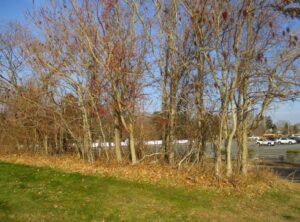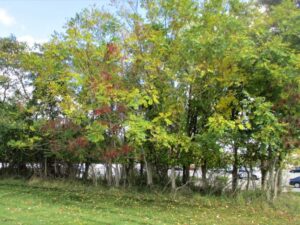EXTREMELY IMPORTANT – PLUS EGG MASS VISUAL GUIDE
Crippling load-by-load phytosanitary requirements are a very REAL concern for the nursery industry this spring.
WE as an industry are in this together, in order to safeguard our industry please do the following:
- SLF Training Permits for hang-tags (click here) are required for each company driver who delivers your plants out-of-state. This training is relatively simple and you can also obtain Training materials to educate your employees (click here)
- Scout every plant for ANY SLF life stages – from dead adults to egg masses. REMOVE any egg masses prior to shipment and train employees to know the various appearances of SLF egg masses.
- Use this guide – SLF EGG MASS GUIDE – USE FOR TRAINING (click here to download) (print and hang up / distribute to personnel)
- Refer to this great resource from Penn State: Spotted Lanternfly Management Guide (click here)
- An excerpt pertaining to the use of Dormant/Hort oils to suffocate egg masses (note this is not enough for plants about to be shipped (scraping required!), rather this may be considered for plants with SLF that are not being shipped this spring)Ovicides to Kill Egg Masses
Experiments have shown that some insecticide sprays can kill SLF eggs. So far, all experiments were done between February and April using egg masses that had intact protective coverings. The most effective insecticides tested that are registered for use on ornamentals were horticultural and dormant oils. When oils were applied directly to the egg masses at a concentration of at least 3 percent, they were effective in killing up to 75 percent of treated eggs. Labels must be followed to prevent plant damage, and not all plants should be sprayed due to phytotoxic damage potential.These experiments suggest that registered insecticidal oils may provide some control of eggs if they are applied between February and April in high enough volumes to get excellent coverage. Oils offer a lower-toxicity option and may provide some control of egg masses that are not accessible for scraping or smashing. However, for egg masses that are within a reachable area, scraping or smashing will provide greater efficacy than currently available ovicides. We are actively researching other ovicides that could provide increased control, and we encourage you to stay up to date on our progress.
- An excerpt pertaining to the use of Dormant/Hort oils to suffocate egg masses (note this is not enough for plants about to be shipped (scraping required!), rather this may be considered for plants with SLF that are not being shipped this spring)Ovicides to Kill Egg Masses
Please be diligent in this matter. Early season sprays to target nymphs will be discussed soon, but for now remove ANY and ALL signs of SLF in ANY SHIPMENTS!
Use this guide – SLF EGG MASS GUIDE – USE FOR TRAINING (click here to download)
The following is an alert and reminder from NJDA and NJNLA, and Nick Polanin’s prior post…
Grower Alert: Don’t Let Spotted Lanternfly Impact Spring Shipping
The spring shipping season is upon us, and Spotted Lanternfly (SLF) should be one of your top concerns. You are probably well aware of the shipping disruptions that could occur if any life stage of Spotted Lanternfly is found on outbound deliveries from NJ growers.
No doubt many of you heeded the NJ Dept. of Agriculture’s recommendations last fall and implemented control measures to prevent the spread of neighboring infestations into your nursery or greenhouse facility. To the extent that those efforts might have come up short, you would be well advised to begin scouting and removing any egg masses (and adult carcasses) from your crops – especially as items are being loaded for shipment. Otherwise, you run the risk of contaminated shipments being fully rejected by the vigorous inspections that are planned at out-of-state retail and landscape destinations this season.
Even though you may disagree with these measures, be advised that it remains within the discretion of any state to impose crippling load-by-load phytosanitary requirements on future deliveries.
Load-rejections that occurred last fall underscore the seriousness of the Spotted Lanternfly situation and the far-reaching impact it might have on your business and the NJ industry at large.
Additionally, Spotted Lanternfly training permits are required for each company driver who delivers your plants out-of-state. This training is relatively simple and available online by clicking HERE.
Should you have any questions, please feel free to reach out to NJNLA (609-291-7070) or the NJ Department of Agriculture Plant Diagnostic Lab (609-406-6939).
Joseph Zoltowski, NJDA; Ed Overdevest and Lori Jenssen, NJNLA


